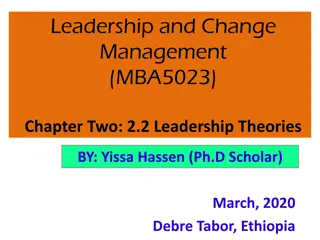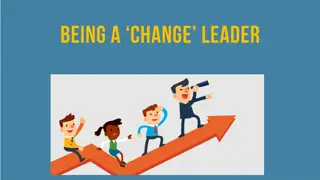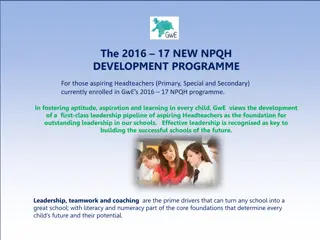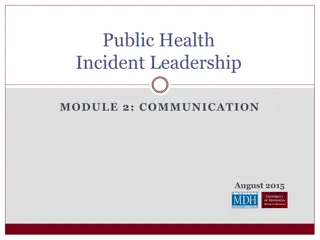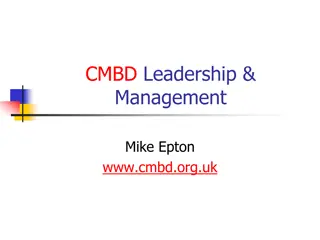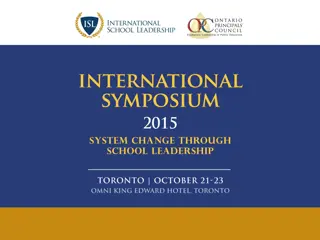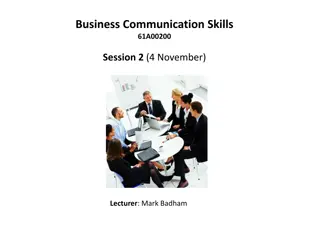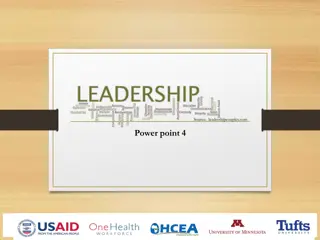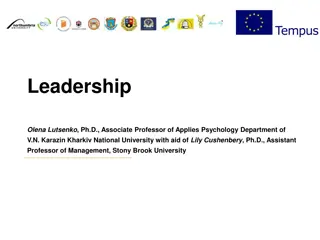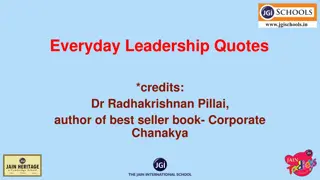Leadership Communication: Effective Strategies and Challenges
Dive into the crucial aspects of leadership communication, including why it's essential, how to communicate effectively, and the complexities faced in conveying messages. Explore persuasive communication techniques, the role of ethos in credibility, and creating a positive ethos to enhance communication impact.
Download Presentation

Please find below an Image/Link to download the presentation.
The content on the website is provided AS IS for your information and personal use only. It may not be sold, licensed, or shared on other websites without obtaining consent from the author.If you encounter any issues during the download, it is possible that the publisher has removed the file from their server.
You are allowed to download the files provided on this website for personal or commercial use, subject to the condition that they are used lawfully. All files are the property of their respective owners.
The content on the website is provided AS IS for your information and personal use only. It may not be sold, licensed, or shared on other websites without obtaining consent from the author.
E N D
Presentation Transcript
L eadership communication Dorji Wangchuk Professor, researcher, writer VToB Conversation, 24-25th October, 2020
Disclaimer & Definition I am not the best communicator Leader is anyone with any level of influence Teachers are leaders. Principals, obviously
Why leadership communication In this presentation How to communicate effectively Compassionate leadership: What, why and How
Leadership communication: Why Primary role of a Leader is to inspire To inspire = communicate vision, views, plans, instructions, information, ideas, advices, knowledge, wisdom, experiences, suggestions, etc.
Communication is NOT easy Noice Wrong context Fuzzy thinking No credibility Wrong medium Poor formatting Bad weather Wrong audience Poor timing Cultural misconception Unclear message Cognitive dissonance Wrong language
Persuasive communication In ancient Greece, the sophists used: Ethos (Credibility and Ethics) Pathos (Emotions and Feelings) Logos (Logic and Reasoning) (Example: My opening presentation slide)
Persuasive communication
Example I am not the best communicator Leader is anyone with any level of influence Teachers are leaders. Principals, obviously Logos (logic) Pathos (emotions) Ethos (credibility) Logos (logic) Pathos (emotions)
Creating positive ethos (credibility/ethics) Character (inner) Be honest, honourable, truthful, fair and ethical Appearance (outer) Presentable, charismatic, expert, titles/positions
To develop logos and pathos See. Feel. See with your heart. Not just with your eyes Listen with your heart! Not with your ear Mindful listening Get honest feedback Read deeplyand apply! Think and analyse (e.g. Even a scanner can read) Act. There is no of wits and knowledge if you don t act
When communicating Begin with WHY The broader picture of the topic - the end goal (e.g. Begin your lesson every day with the broader purpose) Follow the Rule ofThree Not more than three messages Paragraphs with three sentences Tell stories. Stories stick. Stories inspire
Example: How to read deeply Boat is life Row your boat. No one will row for you Row, row, row your boat Gently.Don t rush Life (boat) will float away anyway Stream is time Gently down the stream. Be merry (happy) Merrily (4 times). Be happy all the time Merrily, merrily, merrily, merrily Past = dream Dreams, reality, illusion are the same Life is but a dream
C ompassionate leadership Leadership approach in the new century
Compassionate leadership: What Compassionate leadership is about self-awareness of others and their feelings, empathizing to their conditions and circumstances, and a desire to actto relieve the suffering.
Compassionate leadership: Why Technology have given us a sphere of influence and power Leadership of the future
Traditional leadership styles Control+Alt+Delete Rulebook keepers Saviors and patriots Profit seekers You don t grow
Compassion beyond the concepts Compassion ( ) and loving- kindness ( ) are core practices in Buddhism In Mahayana Buddhism they are pre-requisites to become Bodhisattva ( ) Words and concepts don t walk (e.g. A study in the US)
Compassionate leadership: Know yourself Three key elements: 1. Self-awareness About give yourself the time Better understanding of ourselves We experience ourselves as unique and separate individuals Our areas of strength Our areas where we need improvements Attention training, mindful breathing
Compassionate leadership: True happiness 2. Empathetic joy ( Mudita) Life is about pursuing happiness (dewa and gawa) dewa and gawa not simple pleasure or joybut true happiness derived from seeing others happy Money can buy happiness (e.g. Experiment in Canada) Empathy - tuning into other people Empathetic joy comes from deep inside (limbic brain - controls emotions and is where wisdom sits) - dewa; gawa; Sanskrit:
Compassionate leadership: Wisdom 3. Understanding of the ramifications Undertanding the larger social, political, economic, cultural or religious contexts Information is NOT knowledge. Knowledge is NOT wisdom Knowledge is the ability to link various information. Wisdom is the capacity to use the knowledge as per one's values within a larger contexts and circumstances. Wisdom comes from imagination and creativity





